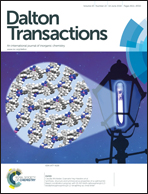Zinc halide template effects on the construction of [1 + 1] flexible Schiff-base macrocyclic complexes having pendant-armed dialdehyde components†
Abstract
Two novel pendant-armed dialdehydes (1a and 1b) were prepared by a one-step reaction between 5-chloro-3-(chloromethyl)-2-hydroxybenzaldehyde/5-methyl-3-(chloromethyl)-2-hydroxybenzaldehyde and cyclohexylamine involving two nucleophilic substitutions, and they were used to react with 1,3-propanediamine to prepare Schiff-base macrocyclic complexes in the presence of ZnX2 salts (X = Cl, Br, and I). As a result, five dinuclear (2a, 2b, 3b, 4a, and 4b) and one mononuclear (3a) [1 + 1] flexible macrocyclic Zn(II) complexes have been structurally and spectrally characterized. The zinc centers in three pairs of macrocyclic complexes have the common four-coordinate tetrahedral geometry with one or two coordinated halide ions, where the template Zn(II) cations and the auxiliary halide anions with different sizes and coordination abilities are believed to play important roles in forming the resulting macrocyclic complexes. In addition, subtle alterations of electron-withdrawing and electron-donating substituted groups (Cl versus CH3) in the macrocyclic backbone result in different 1H NMR and UV-vis spectra.
![Graphical abstract: Zinc halide template effects on the construction of [1 + 1] flexible Schiff-base macrocyclic complexes having pendant-armed dialdehyde components](/en/Image/Get?imageInfo.ImageType=GA&imageInfo.ImageIdentifier.ManuscriptID=C4DT00605D&imageInfo.ImageIdentifier.Year=2014)

 Please wait while we load your content...
Please wait while we load your content...